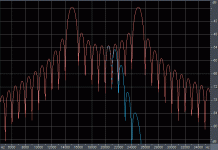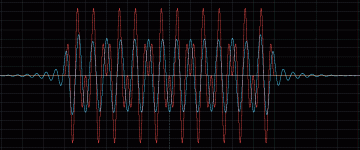As I said, I can't hear any shift in those files. At the moment I believe this to be an exercise in showing potential limitations in relevance to perception of both the usual time and frequency domain measurement techniques. Bob mentioned "wavelet transform" as an alternative but his suggestion didn't get any replies.So after all attemps to explain that the above thesis is wrong, maybe the scaling down effort in #329 might confirm that no frequency shift takes place.
It’s supposedly more accurate for time domain analysis?
Here’s some info.... http://web.iitd.ac.in/~sumeet/WaveletTutorial.pdf
Here’s some info.... http://web.iitd.ac.in/~sumeet/WaveletTutorial.pdf
Last edited:
Well, on a quick look, Hans' wav files line up pretty well... No sign of freq shift.
Still going.? I would think a true frequency shift from a purely additive process would violate causality. IMO the trig identity quoted is a red herring the filtering process involves simple subtraction there is no multiplication or division involved.
...standing waves will occur at dimensions of half the wavelength in pretty much any direction you can find inside the enclosure...
But those standing waves have to be excited. In most bass boxes the dimensions are small enuff that no resonance that could exist is excited. If it is not excited it is as if the resonance does not exist.
dave
One last try, and basically ACK ;-)Nice work, last sentence, well...
I note you ran the full sine instead of one lobe, great. Now run 20 or 30 cycles and look at the output, your blue waveform. Run it for minutes, days if you want. How long does a sine signal have to run to "qualify" as having a frequency?
I'm not being snarky, just curious where a constant frequency wave of any shape graduates to having frequency, as one lobe "clearly" does not qualify.
Also note, your output no longer has the amplitude modulation of the input. That is the crux of this sideband discussion. The more upper sideband removed, the flatter the envelope and the closer to the lower frequency the output gets.
Ps.. I also assume that with 20 or 30 cycles, your spectra will tighten up due to sample size.
Jn
5 periods of the previously presented sin(20k)*sin(5k) aka sin(15k)+sin(25k) waveform, original vs. filtered (same filter as before). Again I think we see the basic characteristic:
- pulse center (now almost 5 periods of 5kHz long) follows the amplitude response characteristic better, little signs of 25kHz (as it is 40dB+ down), and the 15kHz show almost no modulation, accordingly. Tails again deviate and show the natural filter ripple (symmetric as it is a linear phase filter).
- spectrum got much more discrete, more and smaller leafes and the dominant frequencies now pop out more and now sit spot on the expected points.
Bottom line, within the bandwith of the observation the envelope of a signal is almost fully maintained after filtering even when there was content above cutoff which produced an amplitude modulation / beating sum with a very different envelope.
Attachments
Thank you for all your efforts KSTR, your explanations here and in the BT thread have helped me understand what is being seen and why. 🙂
Attached please find listenable samples of the above 5 perdiod blips scaled down from 1MHz (SR I used) to 48kHz, a factor of ~21. So "20kHz" now is a bit below 1kHz. At those frequencies I can't feel anything of the envelope modulation in the time domian, rather I hear two distinct and very homogenous sounding frequency blips overlayed, and when the upper one is removed, well, then I hear the lower one only with still almost the same perceived envelope, with a slightly blurred onset and stop (the lin-phase filter's effect)
Attachments
Perfect, exactly as predicted.One last try, and basically ACK ;-)
5 periods of the previously presented sin(20k)*sin(5k) aka sin(15k)+sin(25k) waveform, original vs. filtered (same filter as before). Again I think we see the basic characteristic:
- pulse center (now almost 5 periods of 5kHz long) follows the amplitude response characteristic better, little signs of 25kHz (as it is 40dB+ down), and the 15kHz show almost no modulation, accordingly. Tails again deviate and show the natural filter ripple (symmetric as it is a linear phase filter).
- spectrum got much more discrete, more and smaller leafes and the dominant frequencies now pop out more and now sit spot on the expected points.
Bottom line, within the bandwith of the observation the envelope of a signal is almost fully maintained after filtering even when there was content above cutoff which produced an amplitude modulation / beating sum with a very different envelope.
Modulated in, flat out. As we can see, any time an envelope causes sidebands above Fs, they are stripped out.
In the cymbal example, it is impossible to understand what content in the signal is basic frequency, and what is modulation envelope. Stripping all above Fs virtually guarantees the upper sideband content which informs envelope will be stripped, meaning the audible envelope is trashed, and any U/S envelopes which create lower sidebands will be stripped as well.
So your statement "within the bandwidth of observation" is EXACTLY the point of the discussion. The modulation envelope is not that far from an exponential decay one would see on a percussion instrument, but as you absolutely point out, stripping everything above Fs totally destroys the attack of a percussion instrument such as a cymbals given the rapid attack creates sidebands that inform the envelope.
If you record the cymbal using a microphone that drops around 20k, this process is of no use. The entire recording chain has to maintain the bandwidth.
I'd elaborate a bit more, but got a dinner to hit..
KSTR, again thanks. Great work.
Jn
??As we can see, any time an envelope causes sidebands above Fs, they are stripped out.
??Stripping all above Fs virtually guarantees the upper sideband content which informs envelope will be stripped, meaning the audible envelope is trashed, and any U/S envelopes which create lower sidebands will be stripped as well.
??The modulation envelope is not that far from an exponential decay one would see on a percussion instrument, but as you absolutely point out, stripping everything above Fs totally destroys the attack of a percussion instrument such as a cymbals given the rapid attack creates sidebands that inform the envelope.
I’m sorry, but if ever someone jumped to conclusions, it is in this posting.
No substance just a bunch of allegations.
Kind of story of the guy with the hammer who sees nails all over the place.
Hans
P.S. What happened to the frequency shift theory ?
See, that's where you must learn the fundamentals.??
??
??
I’m sorry, but if ever someone jumped to conclusions, it is in this posting.
No substance just a bunch of allegations.
Kind of story of the guy with the hammer who sees nails all over the place.
Hans
P.S. What happened to the frequency shift theory ?
Now LEARN.😉
Using a sincos modulation prevents creation of the average carrier.
Using a raised sine creates the carrier.
When sincos is stripped through Fs, only the lower frequency is left.
When a raised sine is stripped, two components are left, the lower frequency and the carrier.
You have been using and not understanding the ramifications of choosing the incorrect modulation, I have said that many time, it is not a natural thing found in music.
That said, you have been a wonderful sparring partner.
Eventually, enough will understand the concept so we can actually discuss the fruit..
Jn
I think the bottom line of this is: The CD sample rate and typical 20kHz brickwall filtering doesn't have a lot of "headroom", if any, to fully capture events like cymbal hits near filter cutoff and Nyquist, and anything above is lost. Since there are chances that we can detect some envelope and time signatures to higher "equivalent frequencies" than what can be heard with pure sines, higher sample rates like 96/192kHz plus a slower, more benign filter seems appropriate to capture both time and frequency information precisly to way beyond 20kHz, and in 24bits.
Just found this one by Eelco Grimm. For our Dutch readers. 🙂
"Brickwall test op 96kHz audio".
https://www.northstarconsult.nl/content/files/variatiesopeenfilter.pdf
"Brickwall test op 96kHz audio".
https://www.northstarconsult.nl/content/files/variatiesopeenfilter.pdf
Now I see where you (and perhaps W&D) went wrong.
Vac,
If your math is correct then one would expect no change.
Here is a real-world experiment. SF6 + 16Ov.2 = Subwoofer Experiment - AVS Forum | Home Theater Discussions And Reviews
Watson Labs (2nd coming of DW) here: WATSON LABS
dave
I don't believe this is how you get people to cooperate with you in your work placeThat said, you have been a wonderful sparring partner.
Vas variance
1.225 * 3432=144k
6.17 * 1352=112k
Wiki - Density of Air said:At 1013.25 hPa (abs) and 15°C, air has a density of approximately 1.225 kg/m³
Wiki - Sulphur Hexaflouride said:Density 6.17 g/L
jneutron - re SF6 said:135 meters per second.
Where kg/m3=g/Lplanet10 said:<snip> ρ x c2 <snip>
1.225 * 3432=144k
6.17 * 1352=112k
Vac,
If your math is correct then one would expect no change.
Here is a real-world experiment. SF6 + 16Ov.2 = Subwoofer Experiment - AVS Forum | Home Theater Discussions And Reviews
Watson Labs (2nd coming of DW) here: WATSON LABS
dave
Hi Dave, thank you for looking this up. It confirms what I said. The 27x ratio increase is postulated by Watson Labs. The guys on AVSforum took this as their departure point. However, they did not find any significant difference between UF6 and air. Totally nothing in the first run, 2dB in the second, also nothing.
Last edited:
The 27x ratio increase is postulated by Watson Labs. The guys on AVSforum took this as their departure point. However, they did not find any significant difference between UF6 and air. Totally nothing in the first run, 2dB in the second, also nothing.
3rd run using a better measuring methodology gave an estimate of a doubling of box size,
And John Janowitz chimed in that the gas in the Watson Labs was pressurized.
I do vaguely remember the bag that was in a unit being repaired. It looked like it could handle pressure. I’ll see in Aaron remembers what he did when he recharged the boxes.
dave
- Home
- Member Areas
- The Lounge
- The Black Hole......

